Your Guide to Types of Packaging Closures
The packaging industry offers a diverse range of containers to package all kinds of products. An equally diverse range of closures are designed to pair with containers for a complete packaging solution. The following is a guide to common packaging closures found in the packaging industry.
What are Caps & Closures in Packaging?
Closures are devices used for opening and closing containers. The term closure includes caps, lids, plugs, and covers. Each type of closure refers to the component found at the opening of a container used for sealing product inside. Closures are used in every industry to seal products ranging from food to chemicals. Closures are designed to pair with a variety of containers such as bottles, jars, tubes, pails and more. Different types of closures are selected based on the end user’s product application such as resealing for reuse or dispensing a specific amount of product.

What is the Difference Between a Cap and a Lid?
Caps and lids are both closures. They can be used interchangeably, but the term ‘caps’ is associated more with smaller screw-on closures such as ones found on bottles, jars, and tubes. The terms “lid” and “cover” are used interchangeably and refer to closures that cover a wide surface area such as a pail or drum. However, “lid” can also be used for referring to jar closures.
Benefits of Choosing the Right Type of Lid and Closure
With an expansive range of containers found in the packaging industry, finding a matching closure is vital for a successful packaging solution. At the foundation, a proper closure will securely seal product inside a container. Additional benefits can vary depending on the closure design. Some closures are designed to deliver a specific experience when used, like dispensing an exact dosage of product or minimizing the risk of children accessing the product inside. Other closures have built-in security such as a tamper evident skirt that will tear off when opened for the first time. Depending on your end user’s experience, different closures can provide a variety of benefits in addition to sealing your product.
Common Types of Threaded Closures
Threaded closures can be identified by the threads that wrap around the inside of a closure. The threads inside the cap grip onto the neck threads of a container with a twisting motion to create a strong seal. Threaded closures are most often found on bottles, jars, and tubes. Closure sizing is identified by the neck finish of the container the closure will match with. The following are some of the common types of threaded closures you’ll find in the packaging industry.
Continuous Thread
The most common style cap is a continuous thread closure. Continuous thread lids and caps serve the basic function of sealing products in a container with a twisting motion. Common styles of plastic continuous thread closures are smooth, ribbed, and dome. Smooth continuous thread closures have a smooth finish, ribbed closures have vertical grooves on the outside edges to allow better grip, and dome closures have rounded edges for a smooth look. Metal continuous thread closures are limited in style and provide the basic function of sealing a container. Continuous thread closures can be used with both plastic and glass containers with a matching neck finish.

Lug Cap
Lug caps are best identified by the popping sound released when initially opening. Unlike continuous thread caps, the threads of lug caps are not continuous and are equally spaced around the container. Lug caps are made of metal and are only compatible with glass jars with a lug neck finish. Lug caps are a popular option for products that need to be airtight such as salsas, jams, and other food products.

Phenolic Cone Cap
Phenolic cone caps are composed of two pieces, the outer cap and an LDPE cone inside the cap. The cap is designed for oil-based products that may seep through a regular continuous thread closure. The cap is often used with glass bottles for products such as essential oils and chemicals.
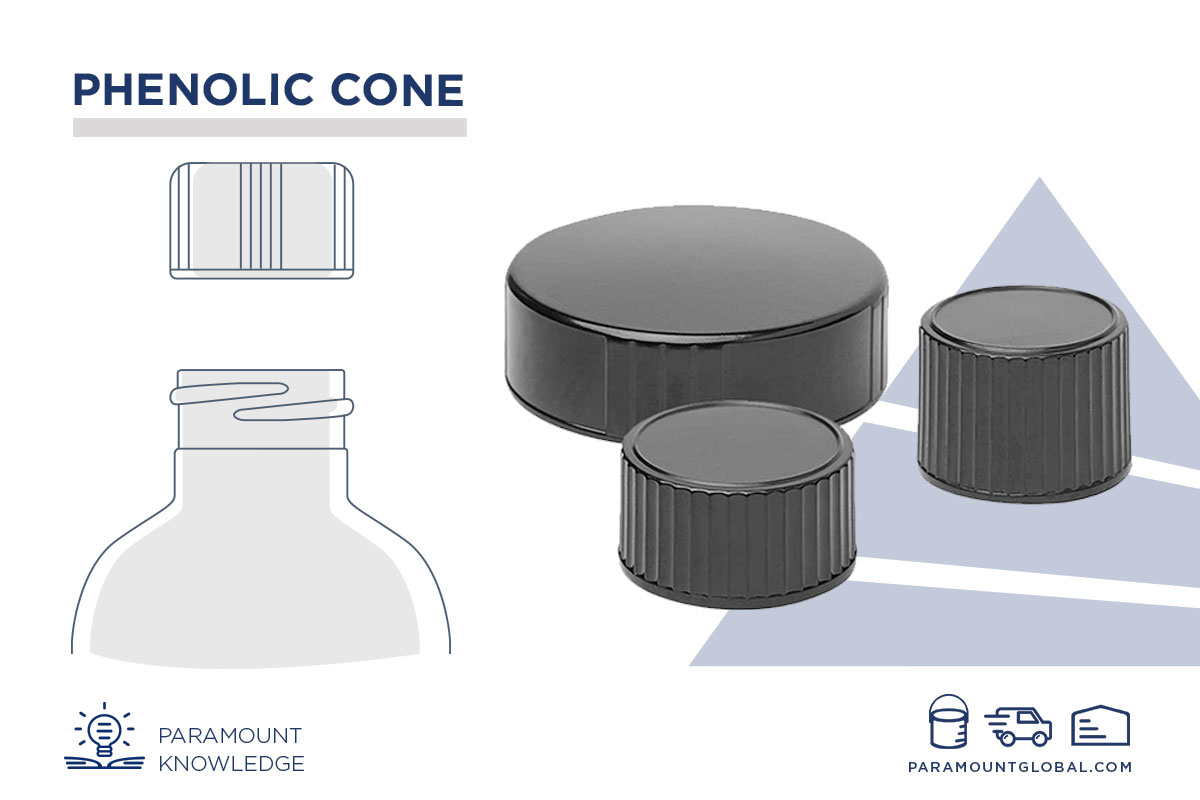
Dispensing Closures
Plastic dispensing closures are threaded closures designed with the additional function of dispensing products. A wide range of dispensing closures are available to accommodate a wide variety of products. Each dispensing closure is designed to dispense a certain amount of product based on the product’s viscosity. Common types of dispensing closures include disc-tops, flip-tops, yorkers, polytops, droppers, pumps, and sprayers. Certain types of dispensing closures are better suited for certain types of products, for example, creams used in the personal care industry are often dispensed with pumps, disc tops, and flip-top caps. Dispensing closures allow a controlled amount of product to be dispensed which effectively reduces wasted product.
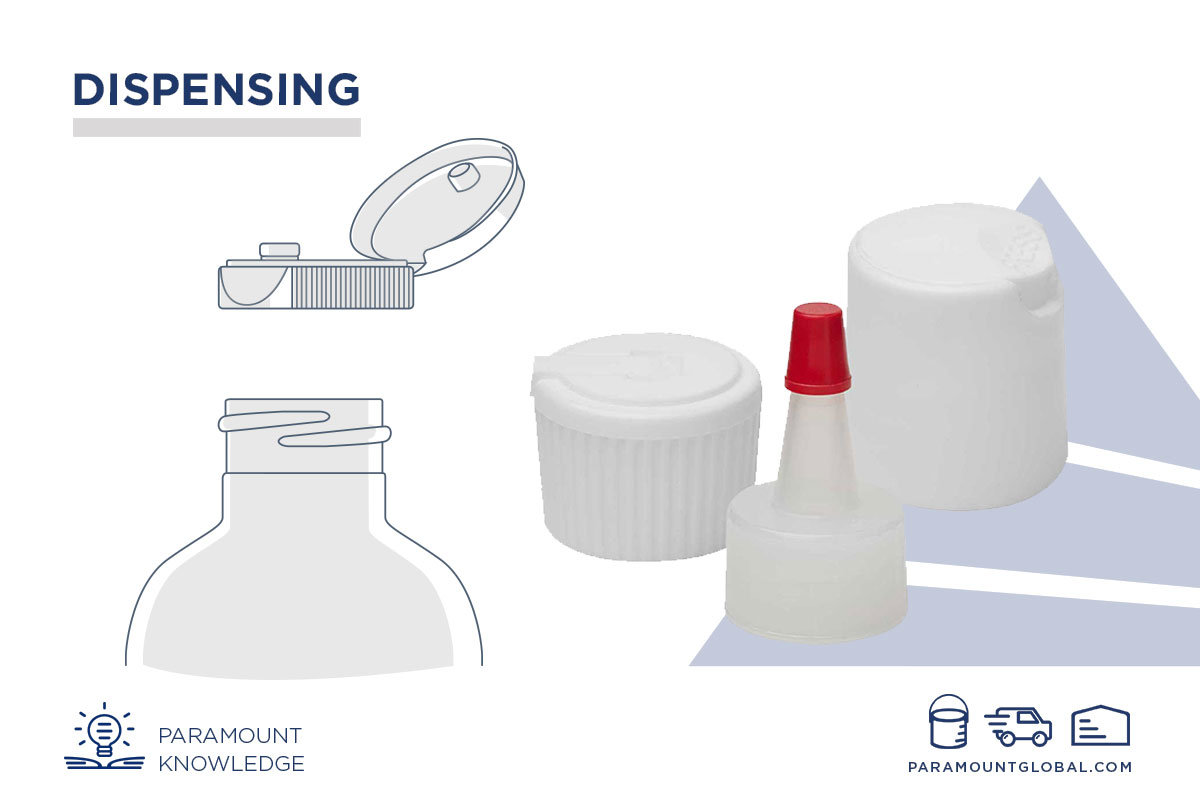
Child Resistant Cap
Child-resistant caps, also known as CRCs, are a type of continuous thread closure that has a mechanism that needs two motions in order to release from the container. The two most common motions needed to release a child-resistant cap are ‘Push Down and Turn’ or ‘Squeeze Sides to Unlock’. Both are designed to be significantly more difficult for children under five to open in order to prevent them from ingesting products that may cause injury or fatality. Child-resistant caps are often found on consumer pharmaceutical or chemical products that may be within reach of small children.
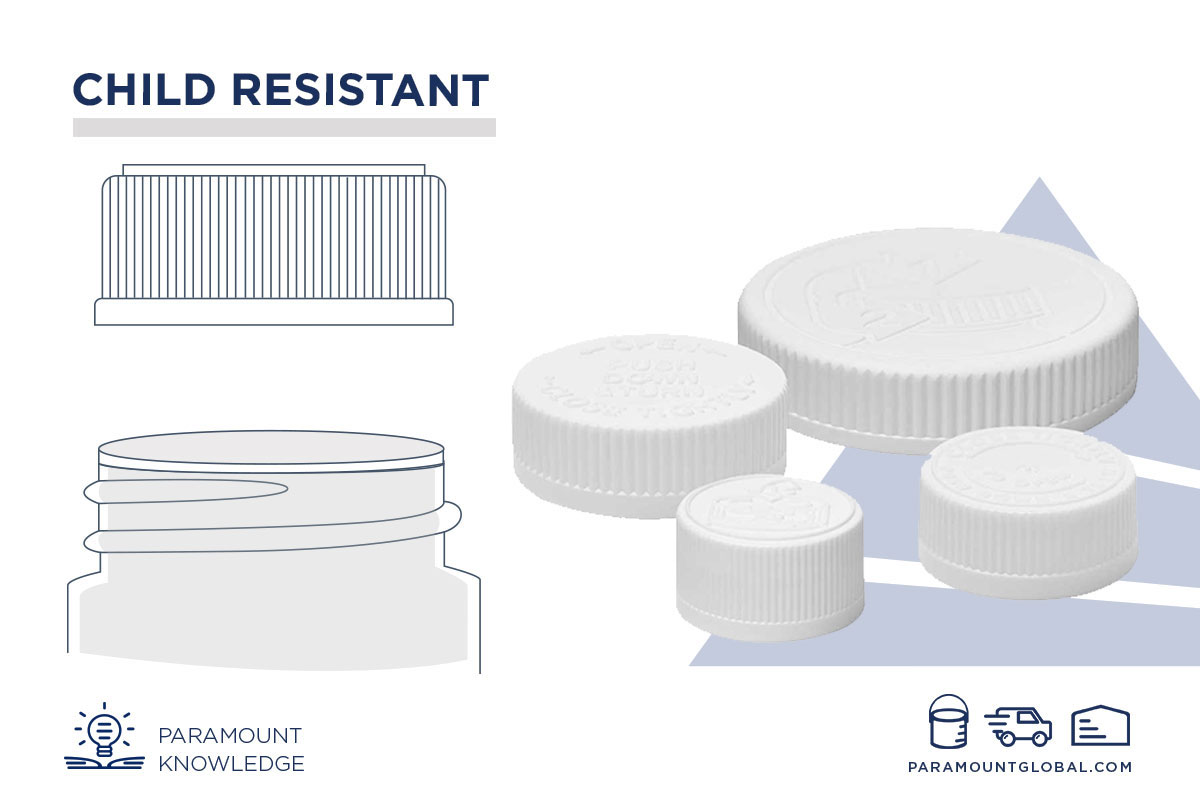
Pail Screw-Top Covers
Screw-top covers are a closure option for plastic pails. A screw-top lid provides a stronger seal than a basic pail lid which relies on pressure to snap and seal. Threaded pails and covers are less commonly used compared to non-threaded pails and covers.
Common Types of Non-Threaded Closures
Non-threaded closures can be identified by the lack of threads that allow the closure to snap on or plugged into a container. Non-threaded closures are typically used with cans, pails, and drums. Non-threaded closure sizing is identified by the matching container size.
Plugs
Plugs rely on pressure to fit into the opening of containers. Metal plugs are a common closure used for round metal cans in the paint & coatings industry. Other types of plugs include interior seals that are friction-fit for tin cans and work well for dry products such as powders or tea.
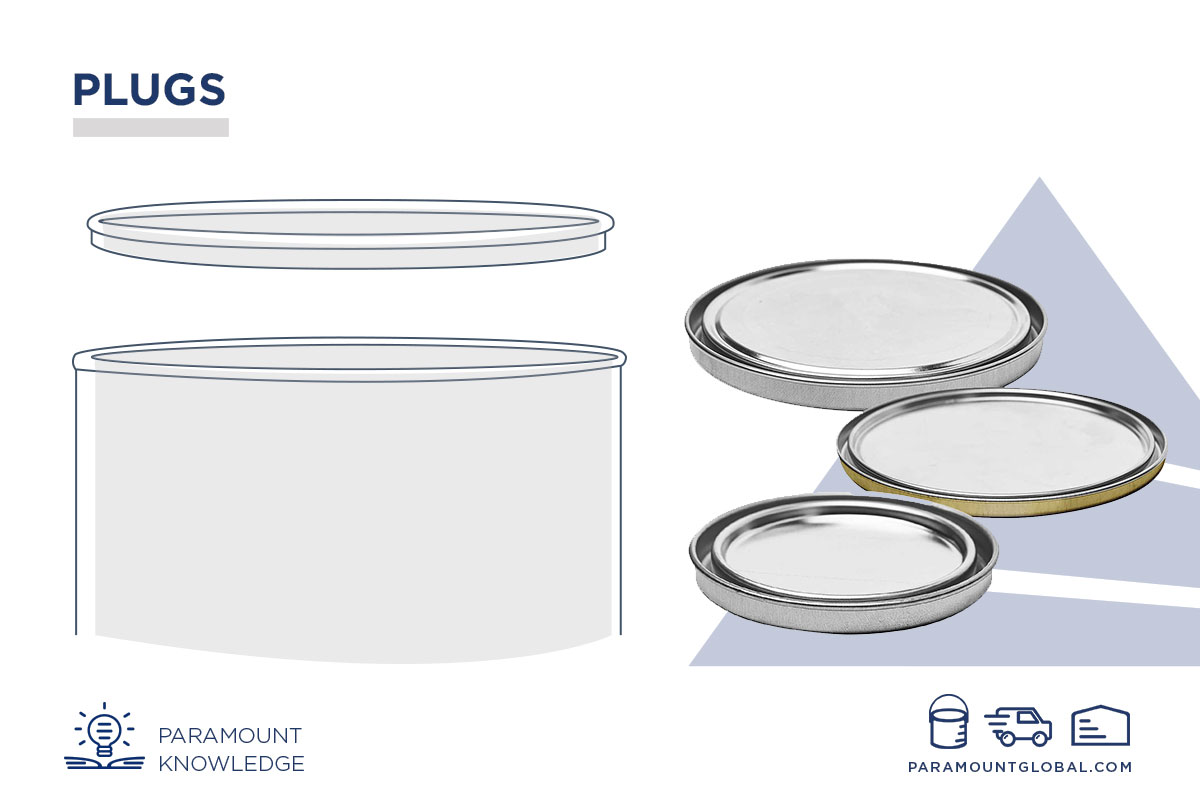
Pail Covers
Pail covers are also available non-threaded and rely on pressure to snap and seal onto an open head pail. Plastic pail covers will snap onto the lip of a matching pail size with pressure. Steel pail lids, on the other hand, need extra pressure with a crimper to seal the edges of the lid to the steel pail. Lever locks are also an option for steel pails where a lever is used to lock a ring onto the pail’s edge. Pail covers can come in a variety of styles depending on the product’s needs. Covers with a gasket work well for liquid products, and other covers offer a spout built into the lid to easily dispense product.

Drum Covers
Drum covers are non-threaded and vary in design based on the material of the drum. Metal open head drums will typically have a cover with a bolt ring that utilizes a bolt to loosen or tighten a metal ring that allows the cover to become released or sealed. Plastic open head drums also use a ring mechanism called a lever lock which instead utilizes a lever to tighten or loosen the cover. For fiber open head drums, covers are available with a lever lock similar to the plastic open head drums or an all-fiber slipcover which does not use any locking feature and simply slips over the opening of the fiber drum.
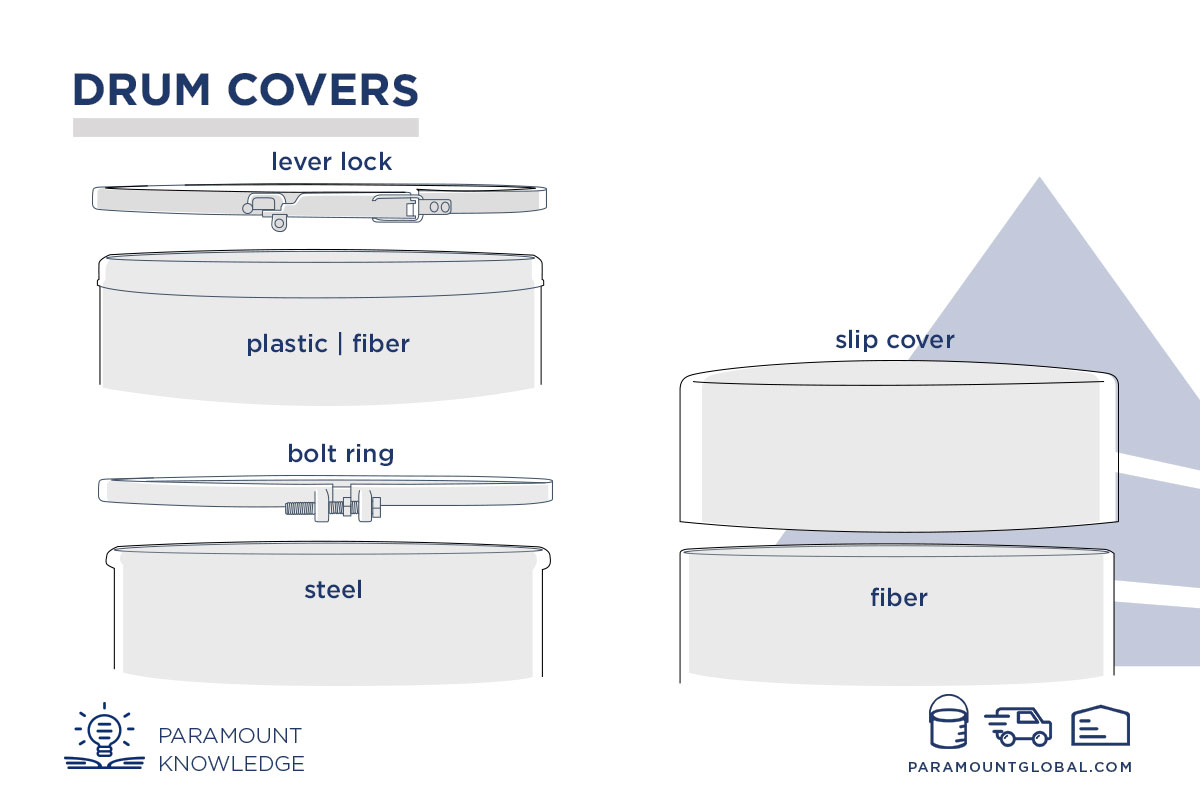
Things to Consider When Choosing Types of Lids and Closures
Similar to choosing the right packaging for your product, there are a few things to consider when completing your packaging solution with the right closure.
Package Compatibility
What size and style container are you using? This will help you quickly narrow down the closure options available for the container. For threaded closures, both the diameter and thread style must match or you may risk the package leaking due to incompatibility.
User Experience
Is there a specific experience you’re looking to provide the consumer? Are controlled dosages helpful to ensure the user is not overusing the product? Depending on how you expect your customer to use your product, different closures with intentional designs for specific types of products can help improve the end user’s experience. Dispensing closures can provide exact product amounts and prevent product waste.
Security
Is the product a potential hazard if ingested? Will the product begin deteriorating as soon as the seal is broken? Some closures are designed to offer different methods of security. Child-resistant closures are designed to prevent young children from accessing products that may potentially be dangerous if ingested. Tamper-evident closures have designs that will provide a signal to the consumer if the container was opened prior to purchasing and may contain a product that has been tampered with.

Choosing the Right Lid & Closure Type for your Products
Identifying the closure options based on the container selected for your product will help narrow down the best design to deliver your product. The following is a quick overview of the best closure options per packaging type.
Bottles
Bottles are designed with a thinner neck to accommodate viscous and liquid products. Most bottles have threaded necks to match with threaded closures for an optimal seal. With a range of product viscosity bottles can hold, an equally diverse range of closures will work with a matching neck finish. Continuous thread and dispensing closures are common options to use with bottles. For bottles that do not have neck threads such as nordic or spirit-type glass bottles, plugs are the best option.
Jars
With a wider opening, jars can be used for solids and higher-viscosity products such as gels and creams. Jars mainly have threaded necks to match with threaded closures for a tight seal. Unlike bottles, glass jars have lug closure options that work well for products that need to be airtight such as salsas and jams. There are some dispensing closures for jars but those are less common.
Cosmetic Tubes
Flexible plastic cosmetic tubes are often used to contain more viscous products such as creams and pastes. Since tubes are sealed on one end, a dispensing cap must be used to retrieve the product from the packaging. Tubes only threaded necks to accommodate a dispensing cap, most commonly Flip top caps are the most common dispensing cap found on tubes, but there is a variety of other dispensing caps available ranging from brushes to sponges.
Paint & Industrial Cans
Paint and industrial cans are typically made of metal and their matching closure components are often also made out of metal. However, since different types of cans serve different purposes, you’ll find different types of metal closures associated with certain types of cans.
For example, round metal paint cans use plugs that rely on pressure for sealing while other types of cans such as conetop, oblongs, and monotop cans have threads for continuous thread closures since these types of cans can store more hazardous products. Some oblongs and conetops do not have threads and have REL openings designed for child-resistant closures. There are application caps with brushes and daubers that are used specifically with monotop cans and commonly selected for packaging coatings and adhesives.
As for aerosol cans, actuator valves uniquely designed for aerosol products are needed to dispense air.
Pails & Buckets
Pails and buckets are used in a variety of industries from food to chemicals. Matching covers in the same material are used for sealing. Plastic pails offer a larger selection of matching lids to accommodate both liquid and dry products. Snap-on covers are the most common option for plastic pails and can vary with different features such as an inner gasket for liquid products or a built in spout for easy dispensing. Screw-on lids are also an option for plastic pails, but are less common. Steel pails are more limited with cover options. Lug covers that require a crimper to seal or a lever lock that uses a lever to clasp the lid onto the lip of the steel pail are the most common options.
Drums and Barrels
Drum covers are limited to lever locks, bolt rings, or slip covers depending on the material of the drum. Plastic open head drums will mainly use a lever lock to create a secure seal. Steel drums rely on bolt ring covers that tighten and loosen with the mechanics of screwing or unscrewing a bolt. Fiber drums are designed for dry products and can be sealed with either a lever-lock cover or an all-fiber slipcover.
Trends in Packaging Closures
Similar to packaging, closures are always being innovated to provide a better end user experience or to keep up with consumer demands. Many dispensing closures are designed to help provide control over the exact amount consumers need to use in order to prevent product waste. Also as consumers demand more sustainable packaging, closures are part of the equation and have been redesigned to meet these demands. For example dispensing pumps typically cannot be recycled due to being composed of different materials (plastic body, metal spring, etc.), but the industry redesigned the closure to be made completely from one type of plastic for easy recycling.

Improve Your Product Packaging & Enhance Your User Experience by Working with an Expert
The world of closures is expansive and diverse. Understanding the basic needs of your products will help guide you towards the best option for a complete packaging solution! However, having a partner who has experience working with similar brands can help you quickly identify the best solution for your unique product. At Paramount Global, we have worked with brands across a wide range of industries. With our network of global suppliers, we can help seek out the best partners to reach your packaging goals. Contact us today to learn more about how Paramount can help with your packaging goals.
Hayley is a marketing professional and copywriter with a background in crafting content for a diverse range of industries. She has been writing about packaging and supply chain logistics for Paramount Global since 2022. She specializes in explaining complex topics in a clear and engaging way and is an advocate for sustainability in packaging and supply chain management.
Read More
For over forty years, Paramount has been delivering perfectly integrated packaging and supply chain solutions.
